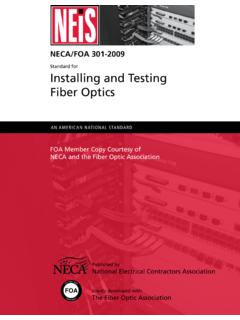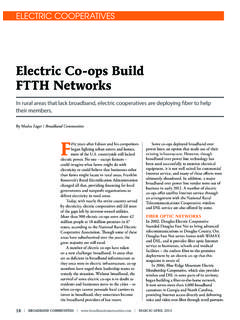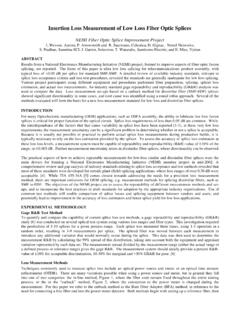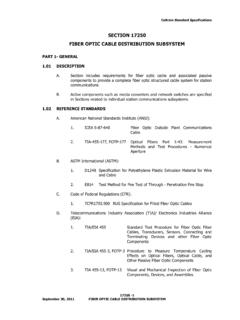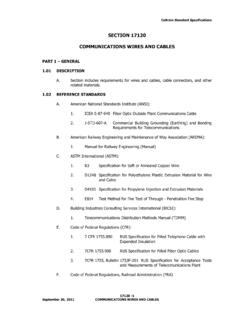Transcription of Broadband Projects - ORIA
1 Broadband Projects Environmental Permitting Guidance What is Broadband ? Broadband is high-speed internet. It improves connectivity to the World Wide Web for homes, businesses, and community institutions such as hospitals, schools, and libraries. These Projects create jobs, improve educational opportunities, and offer better access to health care. Broadband infrastructure includes cell towers, fixed and mobile wireless connections, satellite, coaxial cable, DSL copper connections, and fiber optic cable. The Washington State Broadband Office, housed at the Washington State Department of Commerce (Commerce), has numerous resources including a statewide interactive Broadband availability map (launched in May 2010) based on the latest service data from over 100 Washington Broadband providers. Why is Broadband being built now?
2 Broadband Projects are becoming more common, due in part to funding. Funding sources include: The American Recovery and Reinvestment Act (ARRA). The Department of Agriculture Rural Utility Service. Private provider agreements in connection with mergers and private provider competition in the wireless Broadband market. Other Broadband providers include ports, public utility districts, local governments, and tribal enterprises. How are routes determined? Providers work with customers to design routes and consider environmental issues. Projects must comply with the National Historic Preservation Act (Section 106); the Endangered Species Act (ESA); the National Environmental Policy Act (NEPA); the State Environmental Policy Act (SEPA); and various local, state, and federal permits. Broadband routes might be located on public, private, or tribal lands; along roads or highways, including scenic areas and byways; or under or over water bodies.
3 Aerial installation adjacent to existing power utility infrastructure is common and easy to permit, but less reliable and durable than underground construction. Commerce is working with local planners on Broadband policy planning and development. What's involved in construction? Install designs generally rely on existing overhead and underground utility rights of way, utility poles, etc. Underground installation Photo 1: Underground fiber optic cable installation. methods include plowing with a blade 2-3 inches wide, trenching, and Source: The fiber optic Association. directional boring (see Photo 2) under waterways or to avoid conflicts with other utilities or sensitive areas. Wide channel crossings over navigable waters typically use attachments on existing road or railway bridges. Cable is installed quickly, averaging one mile per day for underground construction and up to five miles per day aerially.
4 It is also installed efficiently, with limited disturbance to the environment, traffic, and vital emergency service access. Page | 1 360-725-0628 800-917-0043. Broadband Projects Environmental Permitting Guidance Local responsibilities Planning departments usually coordinate the permit process with various city or county departments. Contact the planning department where the project is located to learn more. City and county oversight includes critical areas; floodplains; shorelines; certain fish, wildlife, and plant species; building structures; zoning; clearing and grading; road access;. and SEPA. SEPA helps agencies, applicants and the public understand how a project will affect the built and natural environment. State responsibilities State agencies usually become involved because of natural or cultural resources.
5 Common permitting agencies include: The Department of Archaeology and Historic Preservation regulates culture, historic, or archaeological sites. The Department of Ecology regulates multiple aspects of the environment, including water quality and development in or near water. The Department of Fish and Wildlife regulates construction activity in around water. Photo 2: Directional bore machine. The Department of Natural Resources regulates the use of state-owned aquatic Source: The fiber optic Association. lands and forest lands. Federal responsibilities In the event of federal funding, the federal nexus agency is responsible for NEPA compliance, including the ESA consultation with federal agencies. In addition, federal funding under ARRA may allow for unique environmental and historic/cultural compliance. The federal government coordinates with appropriate agencies and tribal authorities if natural, cultural, or tribal resources could be threatened.
6 Tribal responsibilities Tribal governments regulate activities on reservations and act to protect lands identified as their Usual and Accustomed hunting, fishing, or harvesting areas, and other culturally significant lands. Coordination between federal agencies and tribes, or between the State Historic Preservation Officer and tribes, will be required when Broadband Projects enter tribal lands. Where do I get help? Help is available from many sources, including hiring a qualified consultant, reviewing agency literature and websites, discussing the project with permitting agencies, and contacting the Office for Regulatory Innovation and Assistance (ORIA). Free Resources at ORIA include: Contact Information Center Staff at (800) 917-0043 or or visit our website at Other free resources include: The Washington State Broadband Office: Washington State Department of Commerce: If you require this document in another format, contact Office for Regulatory Innovation and Assistance.
7 Persons with hearing loss can call 711 for Washington Relay Service. Persons with a speech disability can call (877) 833-6341. ORIA Publication ENV-048-12. Page | 2 360-725-0628 800-917-0043.



